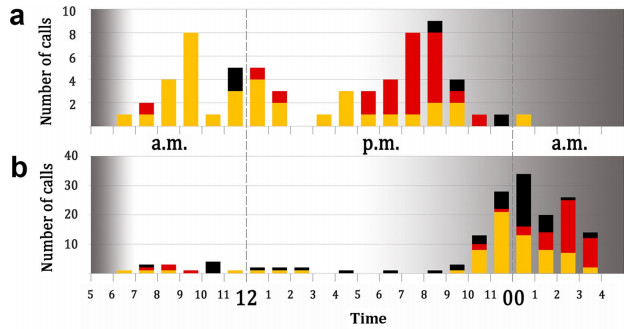
Daily dynamic of calls of Oriental Cuckoo females in captivity. a Male-like calls, b Babbling calls. Yellow color corresponds to female F1, red to F2, and black to F3
Figures of the Article
-
![]() Localities of origin of captive females and where analyzed recordings were obtained in the wild. a The localities of origin of captive females are shown by red circles, while other circles show localities in which the enigmatic vocalizations were either recorded (black circles) or just reporter (grey circles) in the wild. b Studied Oriental Cuckoo females in captivity (photos were taken during the molt). Abbreviations: F1, F2, F3, Oriental Cuckoo females from Khakassia (Kh), Krasnoyarsk Krai (Kr) and Ekaterinburg (Sv), respectively; Pr, recording locality of "Common × Oriental Cuckoo hybrid" in Primorski Krai; Ko, recording locality of "unknown cuckoo" in South Korea; Hb, recording locality of "atypical song of Oriental Cuckoo" in Hebei, China; Tw, recording locality of "atypical song of Oriental Cuckoo" in Taiwan, China (see Additional file 1: Table S1 for details)
Localities of origin of captive females and where analyzed recordings were obtained in the wild. a The localities of origin of captive females are shown by red circles, while other circles show localities in which the enigmatic vocalizations were either recorded (black circles) or just reporter (grey circles) in the wild. b Studied Oriental Cuckoo females in captivity (photos were taken during the molt). Abbreviations: F1, F2, F3, Oriental Cuckoo females from Khakassia (Kh), Krasnoyarsk Krai (Kr) and Ekaterinburg (Sv), respectively; Pr, recording locality of "Common × Oriental Cuckoo hybrid" in Primorski Krai; Ko, recording locality of "unknown cuckoo" in South Korea; Hb, recording locality of "atypical song of Oriental Cuckoo" in Hebei, China; Tw, recording locality of "atypical song of Oriental Cuckoo" in Taiwan, China (see Additional file 1: Table S1 for details)
-
![]() Spectrograms of male-like a–c and atypical d–g vocalizations. The figure shows vocalization of a female F1 Oriental Cuckoo, b female F2 Oriental Cuckoo, c female F3 Oriental Cuckoo, d "unknown cuckoo" from South Korea, e "Common × Oriental Cuckoo hybrid" from Primorski Krai (Russia), as well as f two atypical calls recorded in Taiwan (China) and g atypical call recorded in Hebei Province (China). For A-notes (i.e. notes of both male-like and atypical calls), the numbers highlight position of note in the call (e.g. A2 means the second A-note). Variants of male-like and atypical calls: A1, single-note calls, A1–A2, two-note calls, and A1–A2–A3, three-note call. B, Kuk-call; INT, introductory call. Calls separated by dotted lines are from the same individual; all others are from different individuals
Spectrograms of male-like a–c and atypical d–g vocalizations. The figure shows vocalization of a female F1 Oriental Cuckoo, b female F2 Oriental Cuckoo, c female F3 Oriental Cuckoo, d "unknown cuckoo" from South Korea, e "Common × Oriental Cuckoo hybrid" from Primorski Krai (Russia), as well as f two atypical calls recorded in Taiwan (China) and g atypical call recorded in Hebei Province (China). For A-notes (i.e. notes of both male-like and atypical calls), the numbers highlight position of note in the call (e.g. A2 means the second A-note). Variants of male-like and atypical calls: A1, single-note calls, A1–A2, two-note calls, and A1–A2–A3, three-note call. B, Kuk-call; INT, introductory call. Calls separated by dotted lines are from the same individual; all others are from different individuals
-
![]() Annual dynamic of male-like vocalization of females Oriental Cuckoo in captivity. Yellow color corresponds to female F1, red to F2, and black to F3. The numbers inside squares indicate a date when an individual called (dates when a given individual called in different years are marked with asterisks)
Annual dynamic of male-like vocalization of females Oriental Cuckoo in captivity. Yellow color corresponds to female F1, red to F2, and black to F3. The numbers inside squares indicate a date when an individual called (dates when a given individual called in different years are marked with asterisks)
-
![]() Daily dynamic of calls of Oriental Cuckoo females in captivity. a Male-like calls, b Babbling calls. Yellow color corresponds to female F1, red to F2, and black to F3
Daily dynamic of calls of Oriental Cuckoo females in captivity. a Male-like calls, b Babbling calls. Yellow color corresponds to female F1, red to F2, and black to F3
-
![]() PCA of 42 acoustic parameters of two-note calls of four groups of individuals
PCA of 42 acoustic parameters of two-note calls of four groups of individuals
-
![]() Changes in the amount of neck region inflation while emitting male-like call. The figure illustrated a sequence of three notes of three-note male-like call of female F1. The amount of inflation was estimated by measuring the area of the neck region as indicate by red dotted lines a; the enlargement of the neck region was estimated as the percentages relative to minimal inflation, i.e. before and/or after calling b. Three notes are shown spectrographically in the bottom panel c
Changes in the amount of neck region inflation while emitting male-like call. The figure illustrated a sequence of three notes of three-note male-like call of female F1. The amount of inflation was estimated by measuring the area of the neck region as indicate by red dotted lines a; the enlargement of the neck region was estimated as the percentages relative to minimal inflation, i.e. before and/or after calling b. Three notes are shown spectrographically in the bottom panel c
-
![]() The screenshots of calling postures of males of Oriental a–c and Common d–f Cuckoos. The spectrograms of calls are shown in the bottom panel (g, x-axis = time in s; y-axis = frequency in kHz), and the lowercase letters over blue arrows indicate the time position of corresponding still-frame images a–f. Common Cuckoo male produces the first note of a call with the open beak e, and the second note is produced while the beak is closed f. By contrast, Oriental Cuckoo male produces both notes with the closed beak b, and the beak is opening slightly only just before calling a. The enlargement of throat is characteristic for calling in both species (red arrows), and is the most apparent when the beak is closed. The video-recordings used for the analysis were downloaded from https://www.youtube.com/watch?v=4rq4J8i9QNo (Oriental Cuckoo) and https://www.youtube.com/watch?time_continue=11&v=wejl6ukN8yc&feature=emb_logo (Common Cuckoo)
The screenshots of calling postures of males of Oriental a–c and Common d–f Cuckoos. The spectrograms of calls are shown in the bottom panel (g, x-axis = time in s; y-axis = frequency in kHz), and the lowercase letters over blue arrows indicate the time position of corresponding still-frame images a–f. Common Cuckoo male produces the first note of a call with the open beak e, and the second note is produced while the beak is closed f. By contrast, Oriental Cuckoo male produces both notes with the closed beak b, and the beak is opening slightly only just before calling a. The enlargement of throat is characteristic for calling in both species (red arrows), and is the most apparent when the beak is closed. The video-recordings used for the analysis were downloaded from https://www.youtube.com/watch?v=4rq4J8i9QNo (Oriental Cuckoo) and https://www.youtube.com/watch?time_continue=11&v=wejl6ukN8yc&feature=emb_logo (Common Cuckoo)
Related articles
-
2025, 16(1): 100240. DOI: 10.1016/j.avrs.2025.100240
-
2025, 16(1): 100229. DOI: 10.1016/j.avrs.2025.100229
-
2023, 14(1): 100106. DOI: 10.1016/j.avrs.2023.100106
-
2020, 11(1): 9. DOI: 10.1186/s40657-020-00197-7
-
2019, 10(1): 18. DOI: 10.1186/s40657-019-0158-5
-
2017, 8(1): 27. DOI: 10.1186/s40657-017-0084-3
-
2017, 8(1): 21. DOI: 10.1186/s40657-017-0079-0
-
2015, 6(1): 6. DOI: 10.1186/s40657-015-0015-0
-
2013, 4(2): 187-188. DOI: 10.5122/cbirds.2013.0018
-
2011, 2(3): 125-131. DOI: 10.5122/cbirds.2011.0019


 Download:
Download:

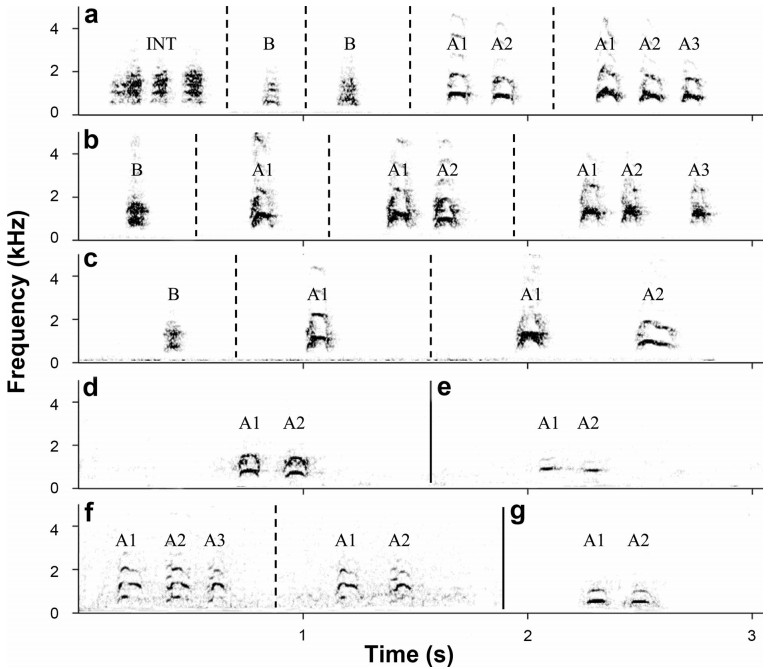
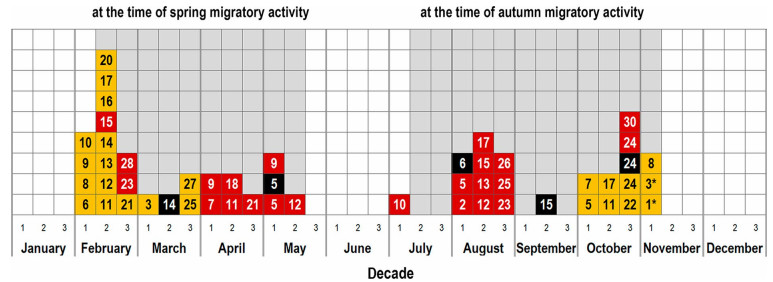

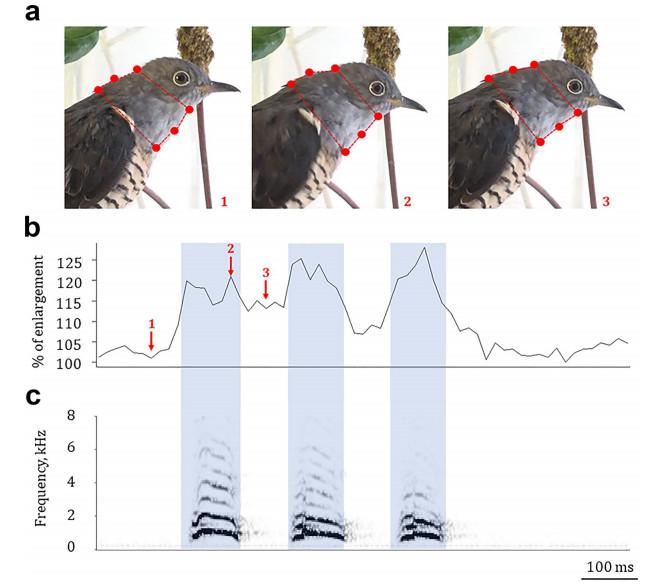
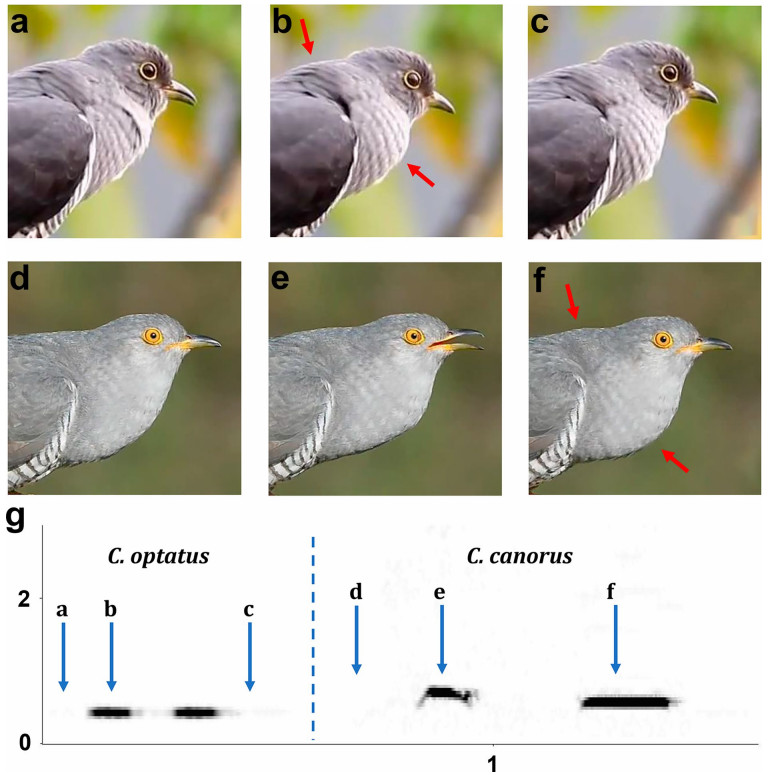





 Email Alerts
Email Alerts RSS Feeds
RSS Feeds